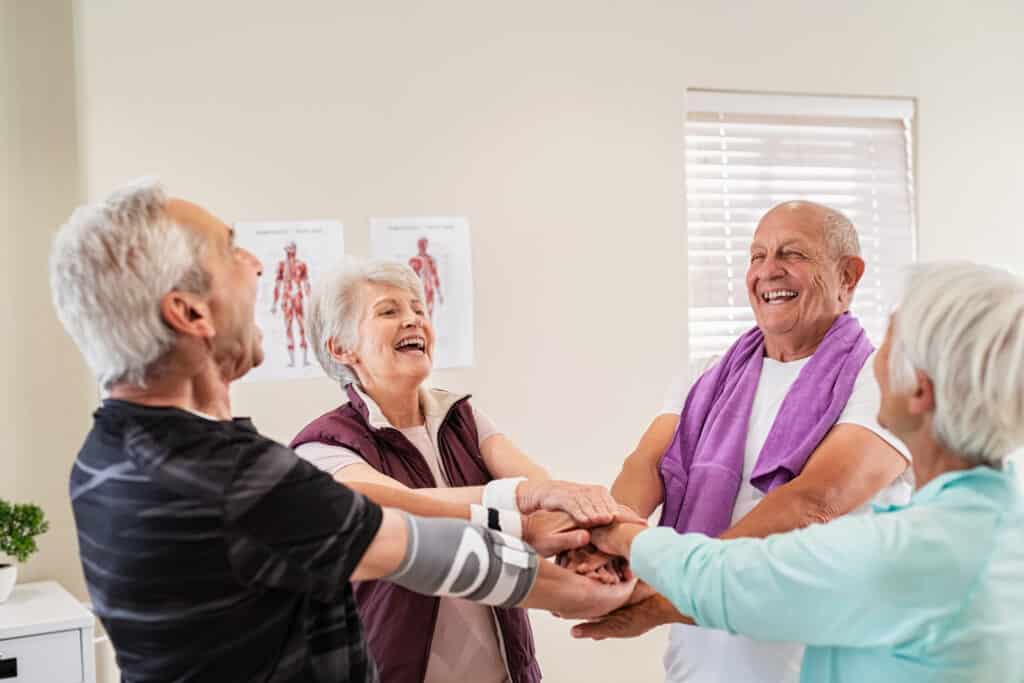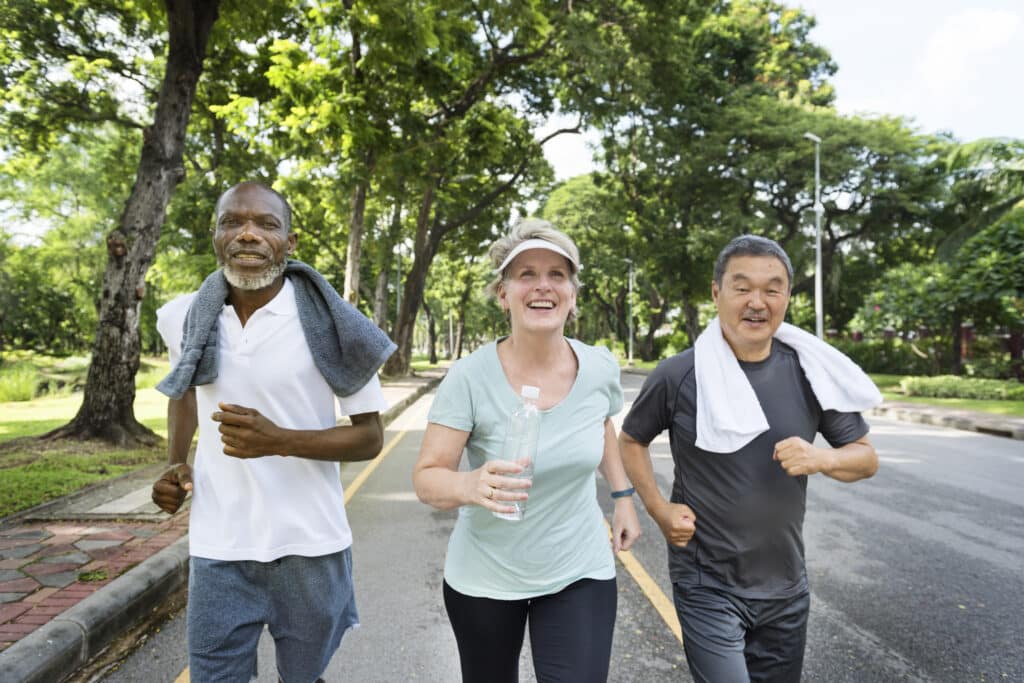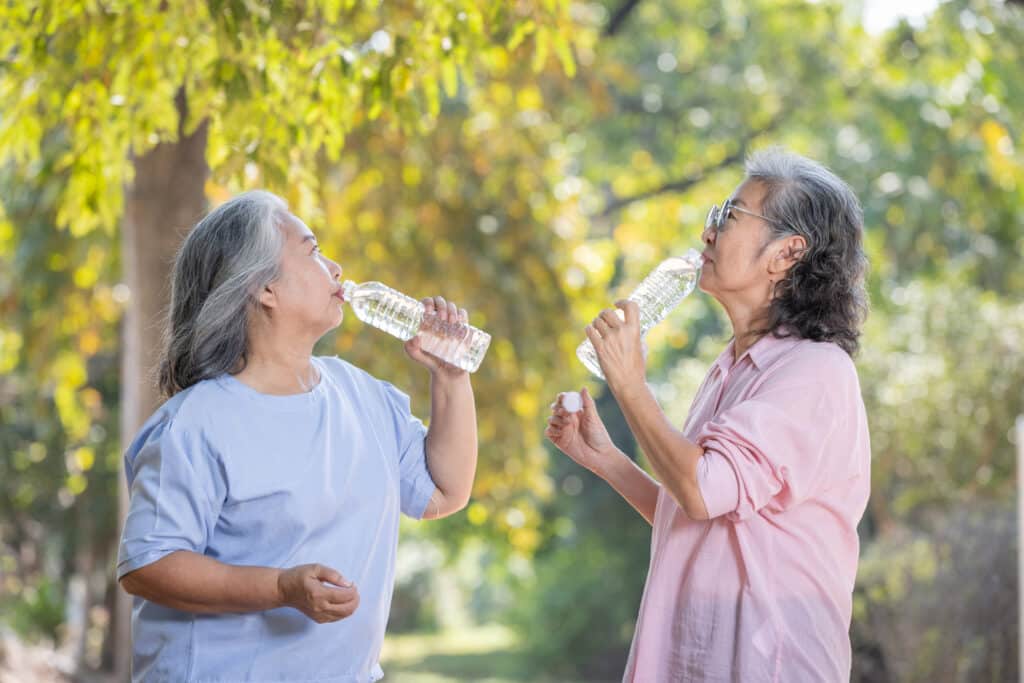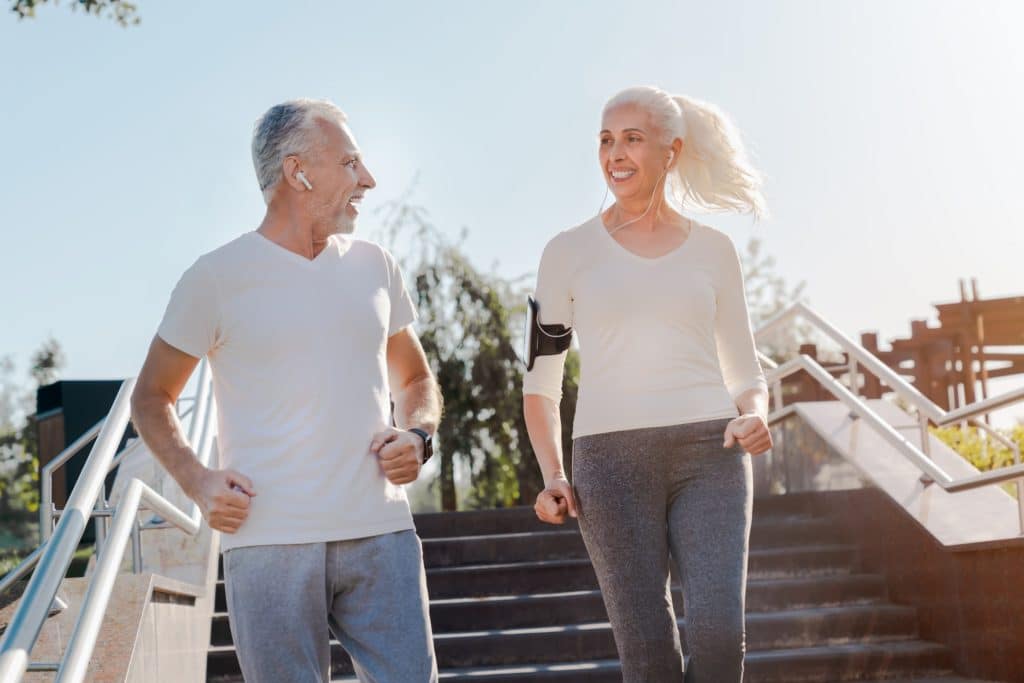Recovering from COVID-19 presents unique challenges, but understanding when to start exercising after COVID is crucial for a smooth and effective recovery.
Regular physical activity can be pivotal in your overall health journey, offering benefits beyond mere fitness. Exercise helps rebuild muscle mass, improves strength, combats fatigue, boosts energy, and enhances cardiovascular efficiency.
Activities like yoga and tai chi can restore balance and coordination, while aerobic exercises can significantly enhance cognitive functions, often impacted by COVID-19-related “brain fog.” Beyond physical benefits, exercise is a powerful mood booster, reducing stress, anxiety, and depression through the release of endorphins.
You can regain your physical resilience, mental clarity, and emotional well-being by carefully resuming exercise with proper guidance. Whether you’ve experienced mild, moderate, or severe symptoms, knowing when and how to restart your fitness routine is essential for a safe and beneficial return to activity.
Reasons to Get Active After COVID-19

Returning to exercise after recovering from COVID-19 offers numerous benefits. Physical activity can play a crucial role in overall recovery and long-term health.
Improve Strength
COVID-19 can lead to muscle weakness, particularly if you experienced a prolonged period of inactivity. Regular exercise helps to rebuild muscle mass and improve overall strength.
Strength training exercises, such as lifting light weights or using resistance bands, can increase muscle strength, making daily activities easier and enhancing physical resilience.
Strength training exercises are crucial for combating the muscle atrophy that often accompanies a prolonged illness like COVID-19. These gentle exercises help you regain muscle mass and improve your functional strength, which is essential for easily performing everyday tasks.
Additionally, building muscle strength can enhance your overall physical resilience, making you less susceptible to injuries and more capable of handling physical stress.1,2,3
Improve Energy and Endurance
One common aftereffect of COVID-19 is fatigue, which can significantly reduce your energy levels.4
Cardiovascular exercises, such as walking, cycling, or swimming, can help boost your energy and endurance by improving your cardiovascular health. Regular aerobic exercise increases the efficiency of your heart and lungs, allowing you to perform daily tasks with less effort and reducing feelings of tiredness.
Cardiovascular exercises are particularly effective at combating post-viral fatigue by improving the efficiency of your cardiovascular system.
These exercises enhance the oxygen and nutrient delivery to your muscles and organs, which helps reduce fatigue and increase your overall energy levels. Incorporating regular, moderate aerobic activities into your routine can significantly improve your endurance, enabling you to engage in prolonged physical activities without experiencing excessive tiredness.
Improve Balance and Coordination
COVID-19 can affect your balance and coordination, especially if you experience severe symptoms or are bedridden for an extended period.5
Balance exercises like yoga or tai chi can help enhance stability and coordination. They also improve proprioception (awareness of body position) and can reduce the risk of falls and related injuries.6
Practicing balance exercises is essential for regaining stability and coordination after COVID-19. Activities like yoga and tai chi not only improve balance but also enhance body awareness and control.
These gentle, flowing movements challenge balance and coordination, helping to rebuild confidence in your physical abilities and reducing the likelihood of falls and injuries.
Improve Memory and Thinking
There is evidence that COVID-19 may impact cognitive functions, sometimes referred to as “brain fog.”7
Exercise has been shown to have significant benefits for brain health. Physical activity increases blood flow to the brain, which can help improve memory, thinking skills, and overall cognitive function. Engaging in regular exercise can help mitigate some of the cognitive challenges associated with post-COVID recovery.
Exercise is a powerful tool for enhancing cognitive function, especially after experiencing COVID-19-related “brain fog.” Physical activity promotes increased blood flow to the brain, delivering oxygen and nutrients that support brain health.
Regular exercise has been linked to improvements in memory, attention, and overall cognitive function. It can help you regain mental clarity and reduce the cognitive difficulties that can persist after recovering from COVID-19.
Improve Mental Health
The psychological impact of COVID-19 can be profound, leading to increased levels of stress, anxiety, and depression.
Exercise is a well-known mood booster that can improve mental health by releasing endorphins, the body’s natural feel-good chemicals. Regular physical activity can help reduce symptoms of depression and anxiety, improve mood, and enhance overall mental well-being.
The psychological benefits of exercise are particularly important in the context of recovering from COVID-19. Regular physical activity can alleviate the stress, anxiety, and depression that can accompany the illness.8
Exercise stimulates the release of endorphins, which are natural mood elevators. Consistent exercise can reduce mental health symptoms and improve overall emotional well-being.
When to Return to Exercise After COVID-19

If you’ve had COVID-19, it’s crucial to understand when and how to safely resume physical activity. The timeline for returning to exercise depends on the severity of your infection—whether it was asymptomatic/mild, moderate, or severe.
Asymptomatic/Mild Cases
All individuals who test positive for COVID-19 should rest for a minimum of 10 days, regardless of symptom severity. For asymptomatic individuals, this period starts from the positive test date, while for symptomatic individuals, it begins when symptoms first appear.
After the 10-day rest period, those with asymptomatic or mild infections who can perform normal daily activities and walk 500 meters without shortness of breath or fatigue can begin a gradual return to exercise with at least 2 weeks of minimal exertion.
The process can be broken down into four phases:
Phase 1 and 2 (First Two Weeks)
Focus on light activities such as household chores, gardening, walking, yoga, breathing exercises, and light stretching and strengthening exercises.
Phase 3
Progress to more challenging activities, including intervals of brisk walking, jogging, climbing stairs, swimming, and cycling combined with rest intervals. Add an interval per day as tolerated.
Phase 4
Incorporate complex movements that challenge strength, balance, and coordination, such as running with changes in direction, shuffling, and weight-lifting circuits.
After completing these phases, individuals should be able to return to their pre-COVID-19 exercise levels. Each phase should last at least 7 days but may extend depending on individual comfort levels.
Monitoring during and after exercise and the following day is crucial for detecting symptoms like abnormal heart rate, shortness of breath, excessive fatigue, or decreased mental health.
If these occur, it is recommended that you step back to the previous phase or seek medical attention. Keeping an exercise diary can help you track progress and any side effects.
Moderate/Severe Cases
People with moderate or severe COVID-19 are at a higher risk for complications such as cardiac or thromboembolic events.9
If you fall into this category, a healthcare practitioner should evaluate your condition before resuming exercise. Additional testing, including ECGs, imaging, or bloodwork, may be necessary to ensure safety.
The long-term effects of COVID-19, also known as “long COVID,” can include persistent symptoms such as coughing, shortness of breath, muscle aches, increased resting heart rate, and severe fatigue.
These symptoms can last for weeks to months and may interfere with the ability to exercise. Severe infections can also damage organs such as the lungs, kidneys, brain, and heart, with about 25% of severe cases resulting in cardiac damage.
If your symptoms are severe, your doctor should assess persistent symptoms and possibly refer you to post-COVID-19 rehabilitation services before you return to exercise.
General Tips for Safe Exercising After COVID-19

When you start exercising after recovering from COVID-19, following some general safety tips is essential to ensure a smooth and safe return to physical activity.
Warm Up and Cool Down
Warming up before exercise and cooling down afterward are crucial steps in any workout routine. A proper warm-up increases your heart rate, gradually boosts blood flow to your muscles and prepares your body for more intense activity.
It can involve light cardio, such as walking or gentle jogging, and dynamic stretches. Cooling down, on the other hand, helps your heart rate and breathing return to normal gradually. This can include slow walking, static stretching, and deep breathing exercises.
Warming up and cooling down can reduce the risk of injury and improve your overall exercise experience.
Dress Appropriately
Wear comfortable clothing and supportive shoes for a safe and effective workout. Choose breathable, moisture-wicking fabrics that allow for a full range of motion.
Supportive footwear is particularly important to prevent foot and ankle injuries. Shoes designed for your specific type of exercise (running shoes for running, cross-trainers for gym workouts) can provide the necessary support and cushioning.
Stay Hydrated
Hydration is key to maintaining performance and preventing dehydration, especially when exercising. Drink water before, during, and after your workout.
The amount of water you need can vary based on factors such as the intensity and duration of your exercise and the weather conditions.
Sports drinks may be beneficial for longer workouts, providing electrolytes and carbohydrates to help sustain energy levels.
Avoid Extreme Weather
Exercising in extreme weather conditions, whether hot or cold, can be dangerous. High temperatures and humidity can lead to heat-related illnesses like heat exhaustion or heat stroke.
In contrast, cold weather can increase the risk of hypothermia and frostbite. Aim to exercise indoors or during more temperate times when the weather is extreme.
If you must exercise outdoors, dress appropriately for the weather, take frequent breaks, and listen to your body’s signals to avoid overexertion.
Following these general tips can ensure a safer and more enjoyable return to exercise after recovering from COVID-19.
Key Takeaways
- Returning to exercise after COVID-19 aids overall recovery and long-term health.
- Regular exercise rebuilds muscle mass and improves strength.
- Strength training combats muscle atrophy and enhances physical resilience.
- Cardiovascular exercises boost energy and endurance by improving heart and lung efficiency.
- Aerobic activities reduce fatigue by enhancing oxygen delivery to muscles.
- Balance exercises like yoga or tai chi improve stability and coordination, reducing fall risk.
- Exercise increases blood flow to the brain, improving memory and cognitive function.
- Physical activity releases endorphins, improving mood and reducing stress, anxiety, and depression.
- A 10-day rest period is recommended for all COVID-19-positive individuals, with a gradual return to exercise for asymptomatic or mild cases.
- A healthcare practitioner should evaluate moderate or severe cases before resuming exercise.
- Warm up before and cool down after exercise to reduce injury risk.
- Stay hydrated and avoid extreme weather conditions during exercise.
FAQs
When can I start exercising after recovering from COVID-19?
You should rest for at least 10 days after a positive COVID-19 test. After this period, asymptomatic or mild cases can gradually return to exercise, while moderate or severe cases should consult a healthcare practitioner before resuming physical activity.
What types of exercises are recommended after COVID-19?
Begin with light activities like walking, yoga, or gentle stretching. Gradually progress to more challenging exercises such as brisk walking, jogging, swimming, and cycling. Incorporate strength training and balance exercises like tai chi as you rebuild your strength and endurance.
How can exercise help improve my recovery from COVID-19?
Exercise can help rebuild muscle mass, improve cardiovascular health, enhance balance and coordination, boost cognitive function, and improve mental health by reducing stress, anxiety, and depression.
What precautions should I take when resuming exercise after COVID-19?
Start slowly and gradually increase the intensity and duration of your workouts. Monitor your symptoms and consult a healthcare professional if you experience abnormal heart rate, shortness of breath, excessive fatigue, or decreased mental health. Stay hydrated and avoid extreme weather conditions.
How can exercise improve my mental health after COVID-19?
Exercise releases endorphins, which are natural mood boosters. Regular physical activity can reduce symptoms of depression and anxiety, improve mood, and enhance overall mental well-being.
Why is it important to warm up and cool down during workouts?
Warming up increases your heart rate gradually and boosts blood flow to your muscles, preparing your body for more intense activity. Cooling down helps your heart rate and breathing return to normal gradually, reducing the risk of injury and improving your overall exercise experience.
What should I wear when exercising after COVID-19?
Wear comfortable clothing made from breathable, moisture-wicking fabrics. Supportive footwear designed for your specific type of exercise (running shoes for running, cross-trainers for gym workouts) is essential to prevent foot and ankle injuries.
How does COVID-19 affect balance and coordination, and how can exercise help?
COVID-19 can impact balance and coordination, especially after severe symptoms or extended bed rest. Balance exercises like yoga and tai chi can help restore stability, improve body awareness, and reduce the risk of falls and injuries.
What should I do if I experience persistent symptoms after COVID-19?
If you have persistent symptoms such as coughing, shortness of breath, muscle aches, increased resting heart rate, or severe fatigue, consult your healthcare provider. You may need additional testing or referral to post-COVID-19 rehabilitation services.
How can I track my progress and ensure safe exercise after COVID-19?
Keep an exercise diary to track your workouts, progress, and any side effects. Monitor your symptoms during and after exercise, and adjust your activity levels as needed. Seek medical advice if you experience any concerning symptoms.
References
- Parker, M., Sawant, H. B., Flannery, T., Tarrant, R., Shardha, J., Bannister, R., Ross, D., Halpin, S., Greenwood, D. C., & Sivan, M. (2023). Effect of using a structured pacing protocol on post-exertional symptom exacerbation and health status in a longitudinal cohort with the post-COVID-19 syndrome. Journal of Medical Virology, 95(1), e28373. https://doi.org/10.1002/jmv.28373
- Soares, M. N., Eggelbusch, M., Naddaf, E., L. Gerrits, K. H., Wiersinga, W. J., Weijs, J. M., Murray, A. J., & Wüst, C. I. (2022). Skeletal muscle alterations in patients with acute Covid-19 and post-acute sequelae of Covid-19. Journal of Cachexia, Sarcopenia and Muscle, 13(1), 11-22. https://doi.org/10.1002/jcsm.12896
- Conte, C., & Muscaritoli, M. (2022). Editorial: Muscle mass and function in COVID-19. Frontiers in Nutrition, 9, 1012742. https://doi.org/10.3389/fnut.2022.1012742
- Longobardi, I., Prado, D. M. L. D., Goessler, K. F., Meletti, M. M., de Oliveira Júnior, G. N., de Andrade, D. C. O., Gualano, B., & Roschel, H. (2022). Oxygen uptake kinetics and chronotropic responses to exercise are impaired in survivors of severe COVID-19. American journal of physiology. Heart and circulatory physiology, 323(3), H569–H576. https://doi.org/10.1152/ajpheart.00291.2022
- Debbie Ehrmann Feldman, Albert Guillemette, Juliana Sanzari, Stéphane Youkheang, Barbara Mazer, Decline in Mobility and Balance in Persons With Post–COVID-19 Condition, Physical Therapy, Volume 104, Issue 6, June 2024, pzae042, https://doi.org/10.1093/ptj/pzae042
- Castro, J. P., Kierkegaard, M., & Zeitelhofer, M. (2022). A Call to Use the Multicomponent Exercise Tai Chi to Improve Recovery From COVID-19 and Long COVID. Frontiers in Public Health, 10, 827645. https://doi.org/10.3389/fpubh.2022.827645
- N., R. C., Sandhu, J. K., Marshall, S., & Besemann, M. (2021). Mitigating Long-Term COVID-19 Consequences on Brain Health. Frontiers in Neurology, 12, 630986. https://doi.org/10.3389/fneur.2021.630986
- Ai, X., Yang, J., Lin, Z., & Wan, X. (2021). Mental Health and the Role of Physical Activity During the COVID-19 Pandemic. Frontiers in Psychology, 12, 759987. https://doi.org/10.3389/fpsyg.2021.759987
- Brogi, E., Marino, F., Bertini, P. et al. Cardiac complications in patients with COVID-19: a systematic review. J Anesth Analg Crit Care 2, 18 (2022). https://doi.org/10.1186/s44158-022-00046-7





